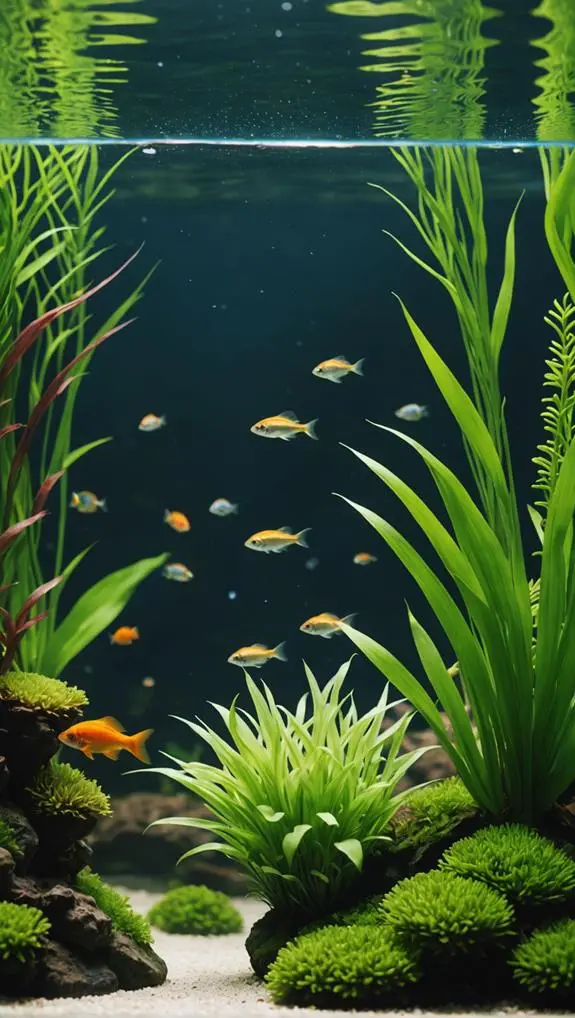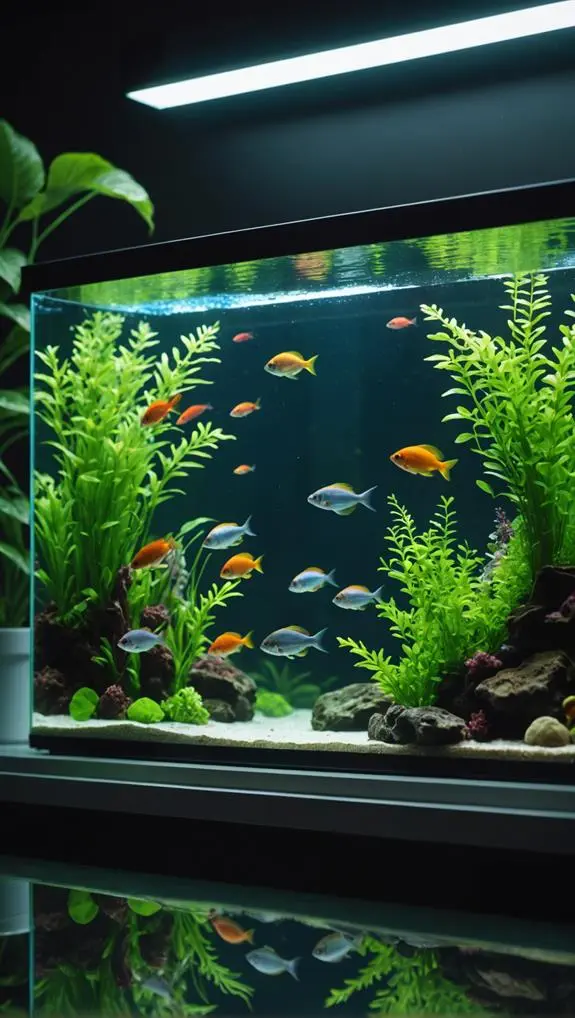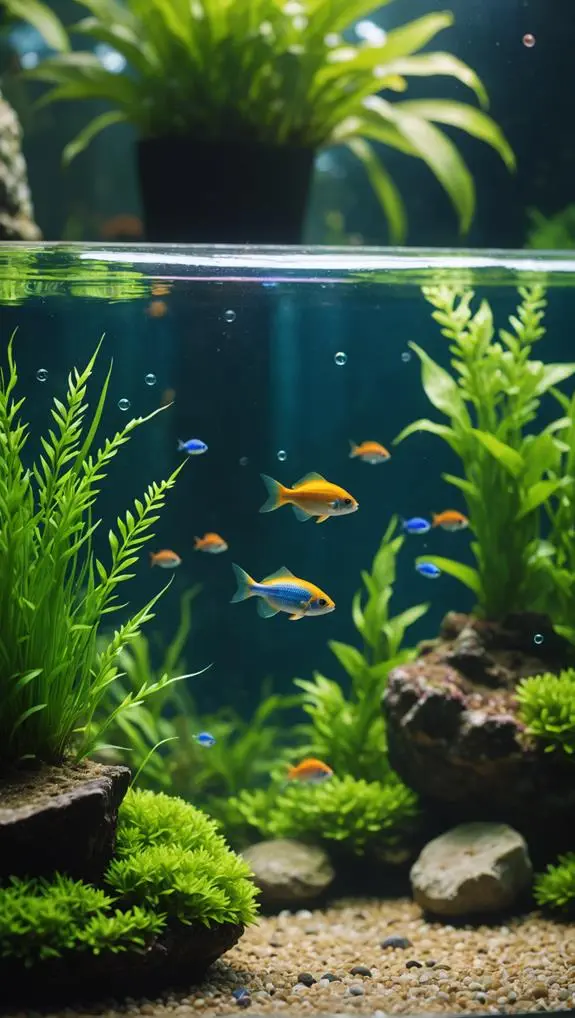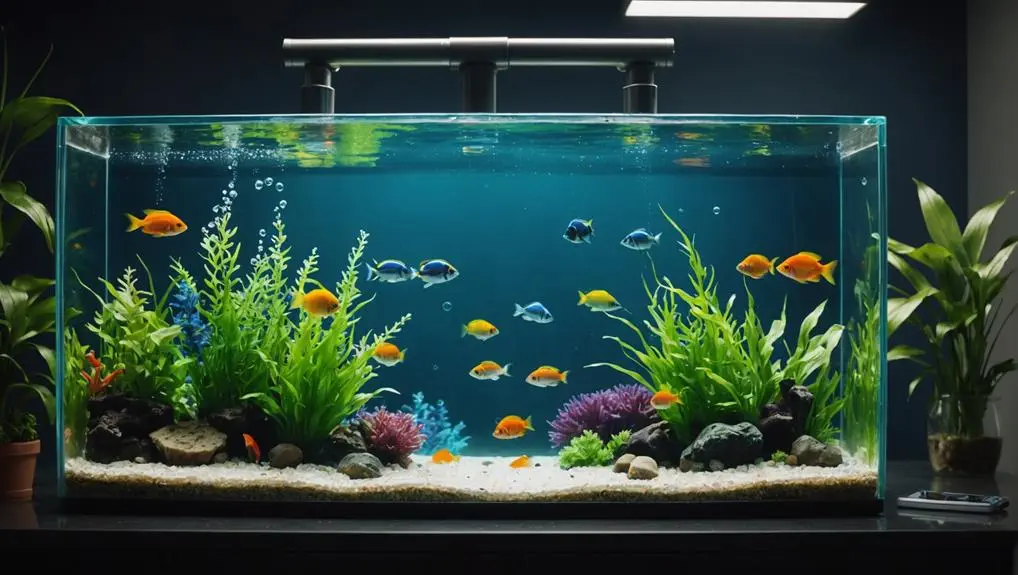To keep your aquarium healthy and happy, you need to focus on a few key treatments. Start by using a good water conditioner to remove harmful chemicals from tap water. Regular water changes of 25-30% each week will keep toxins at bay while enhancing your fish's habitat. Adding beneficial bacteria aids in breaking down waste, and monitoring water parameters, like ammonia and pH levels, is super important. Also, don't forget water clarifiers for clarity! Trust me, your fish will thank you, and they might even throw a little bubble party. Stick around and you'll discover even more tips!
Contents
Importance of Water Quality
Maintaining clean, chemically balanced water is essential for your aquarium's health. You mightn't realize it, but the quality of your water can make or break your fish's happiness. When toxic ammonia levels rise, your fish might feel stressed, leading to poor growth or even illness. That's where beneficial bacteria come in; they're like the superheroes of your tank, working tirelessly to convert those harmful substances into safer compounds.
Regularly monitoring your water quality is key. Aim for a pH between 6.5 and 8.2, and keep ammonia at a perfect 0.0 ppm. Nitrates should ideally be below 30 mg/L.
To maintain these levels, don't skip your weekly water treatment routine. You should replace at least 25-30% of the water to keep your aquatic friends thriving.
Plus, testing water parameters might sound tedious, but think of it as a little spa day for your fish! With just a bit of effort, you'll create a stable environment where your aquatic buddies can flourish.
Treating Tap Water Safely
When preparing tap water for your aquarium, it's crucial to ensure it's safe for your fish. After all, you wouldn't want to invite your friends over for a party in a messy house, right? Tap water often contains harmful chemicals like chlorine and heavy metals that aren't fish-friendly. That's where a good TAP WATER CONDITIONER comes in!
These products, like API STRESS COAT™, are lifesavers. They effectively remove chlorine, chloramines, and heavy metals, making your water safe for fish. Plus, they even promote slime coat protection, which is like a spa day for your aquatic buddies! Instant dechlorination means you can use prepared tap water right away, keeping your tank conditions optimal.
Don't forget to test your tap water regularly! It's a smart way to spot contaminants and ensure the health of your fish.
Start the Aquarium Cycle

Starting the aquarium cycle is super important for your fish's health, as it helps establish beneficial bacteria that keep the water safe.
This process usually takes about 2 to 6 weeks, so patience is key—think of it as waiting for a delicious casserole to bake.
Just remember, adding fish too soon could turn your tank into a toxic soup, and nobody wants that!
Beneficial Bacteria Importance
Establishing beneficial bacteria in your aquarium is essential for kickstarting the nitrogen cycle, which transforms toxic ammonia from fish waste into less harmful compounds.
Think of these bacteria as the unsung heroes of your aquatic world, tirelessly working to keep your fish safe and happy. Without them, ammonia can build up, leading to stressed fish and a sad tank.
This cycling process usually takes about 2 to 6 weeks, depending on your tank's size and how many fish you have. To speed things up, consider using products like API QUICK START™, which introduces live nitrifying bacteria to your aquarium.
It's like giving your tank a jumpstart!
Once these beneficial bacteria are established, they help convert ammonia to nitrite and then to nitrate, which is much easier to manage with regular water changes.
Keeping this balance is crucial for maintaining a healthy environment for your finned friends.
Regularly using beneficial bacteria supplements can help, especially after water changes or if your tank experiences disturbances.
Cycling Duration Factors
The duration of your aquarium's cycling process can vary significantly based on several key factors. Typically, it takes about 2 to 6 weeks to establish a healthy population of beneficial bacteria that break down harmful ammonia and nitrite in your freshwater aquarium. The size of your aquarium, the amount of fish waste or uneaten food, and even the presence of live plants can all influence how quickly this cycle happens.
If you're eager to speed things up, consider introducing live bacteria supplements, like API QUICK START™. These can give your cycling process a helpful boost by providing immediate sources of beneficial bacteria.
It's also crucial to keep an eye on ammonia and nitrite levels throughout this period. Regular monitoring helps you assess the progress of the nitrogen cycle and ensures your fish stay safe and happy.
Lastly, maintaining stable temperature and pH levels will create an optimal environment for the growth of beneficial bacteria. So, while patience is key, you'll be rewarded with a thriving aquarium that serves not just your fish but your passion for aquatic life!
Regular Water Changes
Keeping your aquarium healthy means making regular water changes a priority.
By swapping out 25-30% of the water weekly, you're not just giving your fish a fresh drink; you're also kicking toxins to the curb and reducing stress.
Plus, fresh water helps keep those essential minerals in check, so your aquatic friends can thrive in a vibrant, stable home.
Frequency of Changes
Maintaining a healthy aquarium requires regular water changes to ensure your aquatic life thrives. You should aim for at least a 25-30% water change every week. This simple routine helps prevent harmful chemicals like ammonia and nitrates from building up, which can be detrimental to your fish and plants.
Freshwater tanks really appreciate these partial changes because they replace essential minerals and remove dissolved organics that could harm your fish's health.
Don't forget to precondition your new water with dechlorinator. This step is crucial for eliminating those pesky harmful chemicals found in tap water.
Also, consider doing some gravel vacuuming during your water changes. It's a great way to remove debris and waste that settle at the bottom, keeping everything spick and span!
Regular water changes not only help maintain water quality but also enhance light penetration for your aquatic plants and corals, allowing them to grow healthier.
Think of it as giving your underwater friends a refreshing spa day—because who doesn't love a little pampering?
Water Quality Benefits
Regular water changes deliver significant benefits to your aquarium's overall health and water quality. By regularly performing partial water changes of at least 25-30% each week, you help prevent toxin buildup, keeping harmful ammonia and nitrate levels in check. This simple act can make a world of difference for your aquatic friends!
Not only do water changes improve water clarity, but they also enhance light penetration for corals and aquatic plants, promoting healthier growth and vitality. Plus, they effectively remove dissolved organics that might suppress your fish's immune systems, which can help prevent disease outbreaks.
When you use high-quality marine salt during these changes, you're not just replacing water; you're restoring the essential balance of minerals like calcium and magnesium necessary for coral and aquatic life health. Think of it as giving your aquarium a spa day!
And let's be honest, a well-maintained aquarium doesn't just benefit your fish; it makes your living space more visually appealing, creating a serene environment for you and your loved ones.
Monitoring Water Parameters

Testing key water parameters is essential for a healthy aquarium. You want your freshwater fish to thrive, and ensuring that your water is chemically balanced is a big part of that.
Start by regularly checking ammonia and nitrite levels—ideally, these should be at 0.0 ppm. Nitrate levels should stay between 0 and 30 mg/L to keep your aquatic friends happy.
Next, keep an eye on the pH. For freshwater fish, a stable pH between 6.5 and 8.5 is crucial. Fluctuations can stress fish out, which is the last thing you want!
Don't forget about general hardness (GH) and carbonate hardness (KH), too. A GH of 100-250 mg/L and a KH of 120-300 mg/L contribute to a stable environment.
Using appropriate testing kits weekly is a smart move. It allows you to catch any water quality issues early, giving you time to act.
And let's not forget about temperature; aim for 74-82°F (23-28°C). Keeping your filtration system in check is vital, as it helps maintain these important water parameters. Your fish will thank you for it!
Adding Beneficial Bacteria
Adding beneficial bacteria to your aquarium can significantly enhance the health of your aquatic environment.
These amazing little helpers break down harmful ammonia and nitrite, turning them into less toxic nitrate. This process is crucial for maintaining a healthy aquarium where your fish can thrive.
Here are a few reasons why you should consider adding them:
- Speedy Cycling: They can reduce the time required to establish a balanced nitrogen cycle from weeks to just days!
- Stability Boost: Regularly introducing beneficial bacteria after water changes helps re-establish biological filtration, keeping your tank stable and happy.
- Lower Stress Levels: A healthy population of beneficial bacteria leads to lower stress for your fish, making them more active and joyful.
- Waste Management: These bacteria are essential for effective waste management, ensuring your aquarium stays clean and safe.
Using Water Conditioners

Maintaining a healthy aquarium goes beyond just adding beneficial bacteria; using water conditioners plays a vital role in ensuring your fish thrive. These handy products are essential for removing harmful chemicals like chlorine and chloramines from tap water. You wouldn't want to invite your fish to a toxic pool, right? By using water conditioners, you're giving them a safe environment to swim and grow.
Many water conditioners also include stress-reducing ingredients that support fish health, especially during those nerve-wracking tank transitions or water changes. It's crucial to follow the manufacturer's instructions for the correct dosage, so you don't accidentally overdose your aquatic friends. Some conditioners even promote slime coat development, which acts like a protective shield against diseases.
Regularly using water conditioners helps neutralize heavy metals and other toxic elements, keeping your fish feeling great. Think of it as a spa day for your aquatic buddies!
With just a little effort and the right products, you can create a stable and healthy environment where your fish can flourish. So, let's roll up our sleeves and make sure our underwater pals are living their best lives!
Enhancing Water Clarity
Clearing up your aquarium water is essential for both the health of your fish and the beauty of your setup. When your water is clear, you get to enjoy watching your fish thrive, and they'll appreciate it too!
Here are some effective strategies to enhance water clarity:
- Use water clarifiers: These products can help coagulate tiny particles, making it easier for your filtration system to scoop them up.
- Invest in chemical filtration: Activated carbon is a game-changer. It adsorbs impurities and toxins, contributing to that crystal-clear look.
- Don't skip regular water changes: Aim for at least 25-30% each week. This keeps dissolved organics in check and replenishes clean water.
- Incorporate algae control products: These help minimize excessive growth, keeping your water clear while maintaining a balanced ecosystem.
Frequently Asked Questions
How Do I Keep My Aquarium Water Healthy?
To keep your aquarium water healthy, prioritize regular water testing, maintain tank cleanliness, and use chemical filtration. Incorporate beneficial bacteria for stability, and commit to consistent tank maintenance to ensure a thriving aquatic environment for your fish.
How to Improve Aquarium Water Quality?
To improve your aquarium water quality, ensure effective water filtration, maintain beneficial bacteria, balance pH, and implement algae control methods. You'll create a thriving environment that supports your aquatic life and brings joy to others.
How to Remineralize Aquarium Water?
To remineralize aquarium water, use remineralization methods like mixing purified water with municipal tap water or adding remineralizer products. Regular water testing ensures you maintain the right mineral balance for your fish's health and wellbeing.
What Is Safe Aquarium Treatment?
Imagine your aquarium as a vibrant symphony. For chemical safety, follow dosage guidelines, explore natural alternatives, and ensure treatment effectiveness. This harmony nurtures life, letting your aquatic friends thrive in a safe, balanced environment.
Final Thoughts
So, there you have it! Keeping your aquarium healthy isn't just about pretty fish; it's about creating a balanced ecosystem. Did you know that over 50% of fish deaths in home aquariums are due to poor water quality? Yikes! By treating your water, monitoring parameters, and adding beneficial bacteria, you're not just being a good fish parent—you're ensuring a happy, thriving underwater world. Dive in and give your aquatic friends the best chance at a long life!












